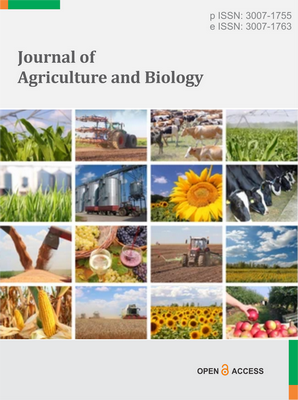Insights into Fusarium wilt of tomato (Fusarium oxysporum f. sp. lycopersici) and its management strategies
DOI:
https://doi.org/10.55627/agribiol.002.01.0837Keywords:
Tomato, Fusarium wilt, Molecular characterization, ManagementAbstract
Tomato (Lycopersicon esculentum), a widely cultivated vegetable rich in vitamins, minerals, and health-promoting antioxidants like lycopene and vitamin C, faces significant production challenges. Among these, Fusarium wilt, caused by the soilborne fungus Fusarium oxysporum f.sp. lycopersici (FOL), is a prevalent and destructive disease in tomato-growing regions worldwide. FOL, a highly damaging ascomycete fungus, poses a serious threat alongside the large populations of nonpathogenic F. oxysporum (NPF) residing in various ecological niches. The disease manifests initially with yellowing of lower leaves, followed by progressive wilting. FOL invades the tomato plant, colonizing the vascular tissue and causing its discoloration to a dark brown hue. This discoloration extends upwards, ultimately leading to wilting, collapse, and plant death. The wilting syndrome is attributed to a complex interplay of factors induced by the fungus, including xylem blockage by fungal mycelia, production of mycotoxins, suppression of host defense mechanisms, and formation of tyloses (cellular outgrowths).. Managing Fusarium wilt is challenging due to the extended survival of the pathogen and its existence in diverse pathogenic races. Conventional approaches, such as deployment of resistant cultivars and application of synthetic fungicides have shown limited efficacy. Additionally, the potential environmental hazards associated with fungicides necessitate a cautious approach. This review explores the use of both chemical and biological control agents in Fusarium wilt management, acknowledging the limitations of single-method strategies. To achieve sustainable and environmentally friendly disease control, an integrated approach is recommended. This review aims to equip farmers with a diverse toolbox of management methods that can be combined into a comprehensive package to combat Fusarium wilt and related soil borne diseases.
Downloads
Published
Issue
Section
License
Copyright (c) 2024 Iqra Kanwal, Atika Iffat, Muhammad Bilal Shaukat, Talha Shafique, Yasir Majeed, Muhammad Irfan Zafar, Hassan Moatasam Awan, Irum Tabbasum, Adeeba Iqbal, Muhammed Tatar, Parnaz Mortazavi, Amjad Ali, Rahma Bejaoui, Humera Aslam, Farwa Seemab (Author)

This work is licensed under a Creative Commons Attribution 4.0 International License.



